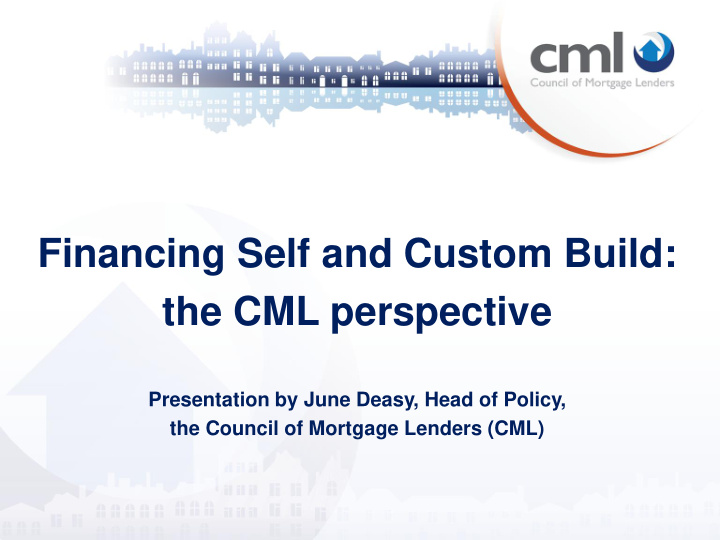



Financing Self and Custom Build: the CML perspective Presentation by June Deasy, Head of Policy, the Council of Mortgage Lenders (CML)
About the Council of Mortgage Lenders • UK-wide trade body representing the first charge residential mortgage lending industry (banks, building societies and specialist lenders). • Our 139 members undertake around 97% of all residential mortgage lending in the UK. • There are 11.1 million mortgages in the UK, with loans worth over £1.3 trillion. • In addition to home ownership, CML members also lend to support the social housing and private rental markets.
Mortgage lending in Scotland (Q2 2016) • Home buyers borrowed £2.2bn for house purchase, totalling 16,500 loans • First-time buyers borrowed £920m (8,500 loans) • Home movers borrowed £1.2bn (8,100 loans) • Remortgage activity totalled £850m (7,100 loans)
Affordability • Affordability metrics for first-time buyers in Scotland remains better than for the UK overall. • The typical amount borrowed this quarter was £99,800 (£132,800 in the UK overall). • Typical average household income of a first-time buyer in Scotland was £33,600 (£40,000 in the UK overall). • The income multiple in Scotland was 3.03; lower than the UK average of 3.51.
Affordability (continued . . .) • Affordability metrics for home movers in Scotland similarly better than for the UK overall. The amount borrowed this quarter was £139,500 (£167,400 in the UK overall). • The typical average household income of a home mover in Scotland was £49,700 (£53,600 in the UK overall) – a 2.84 income multiple (UK average 3.26).
Lending for self and custom build: general considerations • Property must hold value in medium to long term to offer security for a mortgage loan. • Lenders looking for: durability; reparability; adaptability; insurability; quality; saleability. • Lenders only one part of the equation: base decisions on other professions, e.g. valuers, conveyancers, warranty providers, insurers. • Past poor experiences can influence lender decisions.
Lending for self and custom build: challenges • Relatively low demand from mortgage customers • Perceived higher risks associated with lending on self-builds in particular • Higher capital requirements of lenders if lending to the sector • Staged payments can act as a disincentive
Lending for self and custom build: opportunities • Building the evidence base: – How do custom build properties hold their value over time? – How long do self and custom build customers tend to stay in their properties? – What’s the average build out time (from first foundations to completion)?
Lending for self and custom build: Opportunities (continued . . .) • Alternatives to the staged payments model: – Innovative schemes to remove the need for lenders to fund the build until completion stage; using third parties such as local authorities to upfront-fund the build.
Next steps • Enhancing the evidence base • Sharing insight • Monitoring innovative developments • Today’s event a welcome contribution
Recommend
More recommend